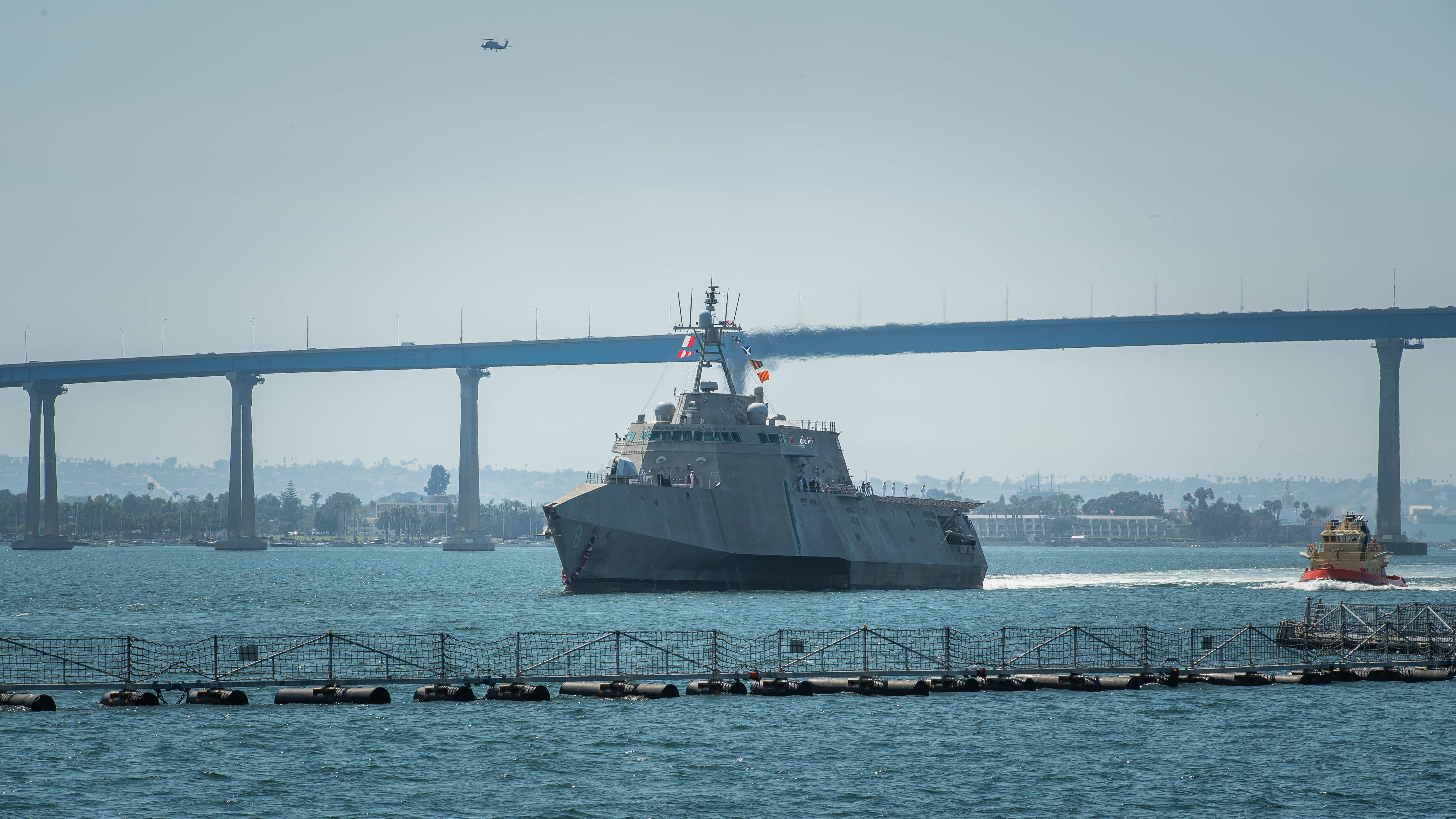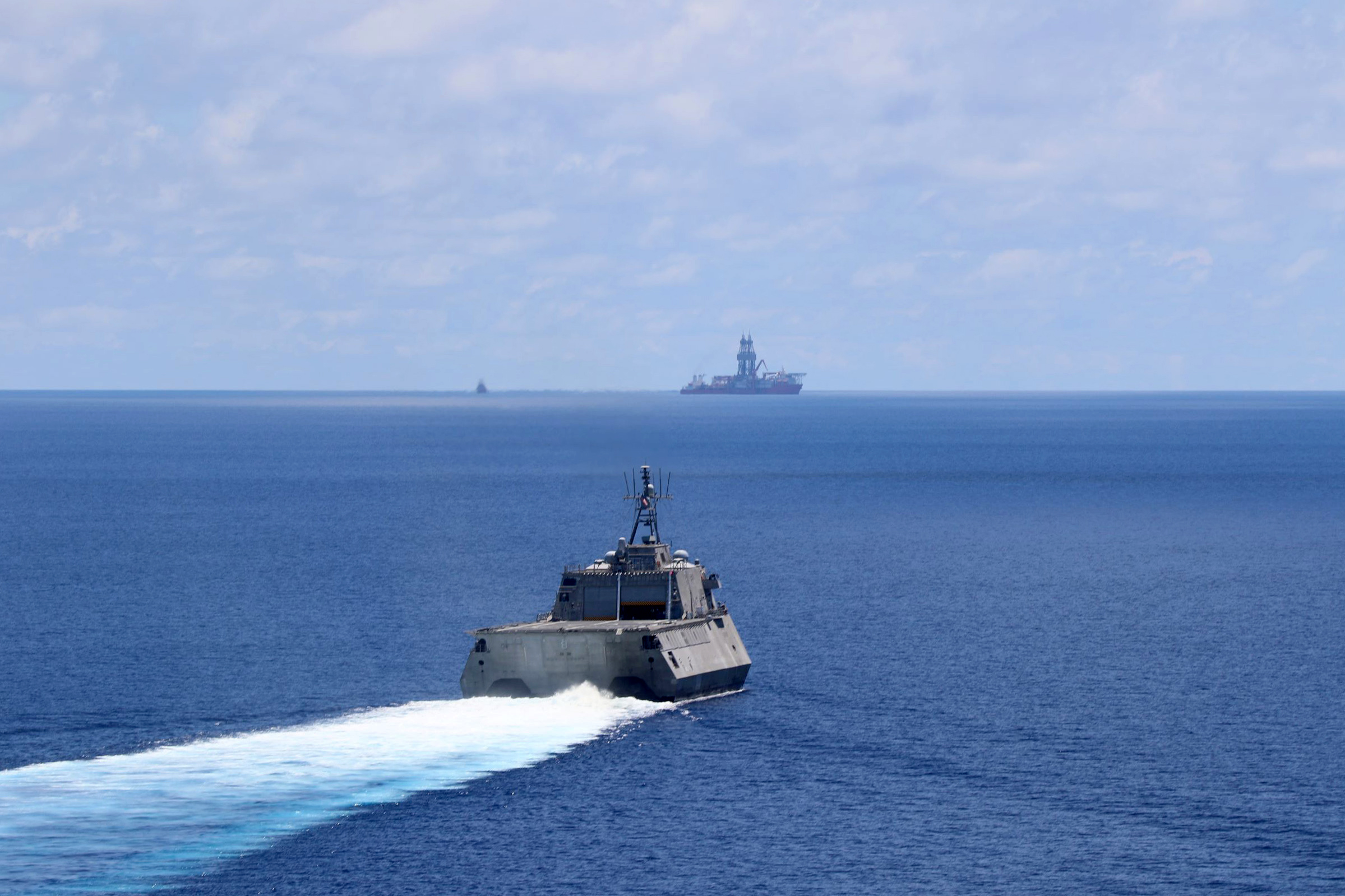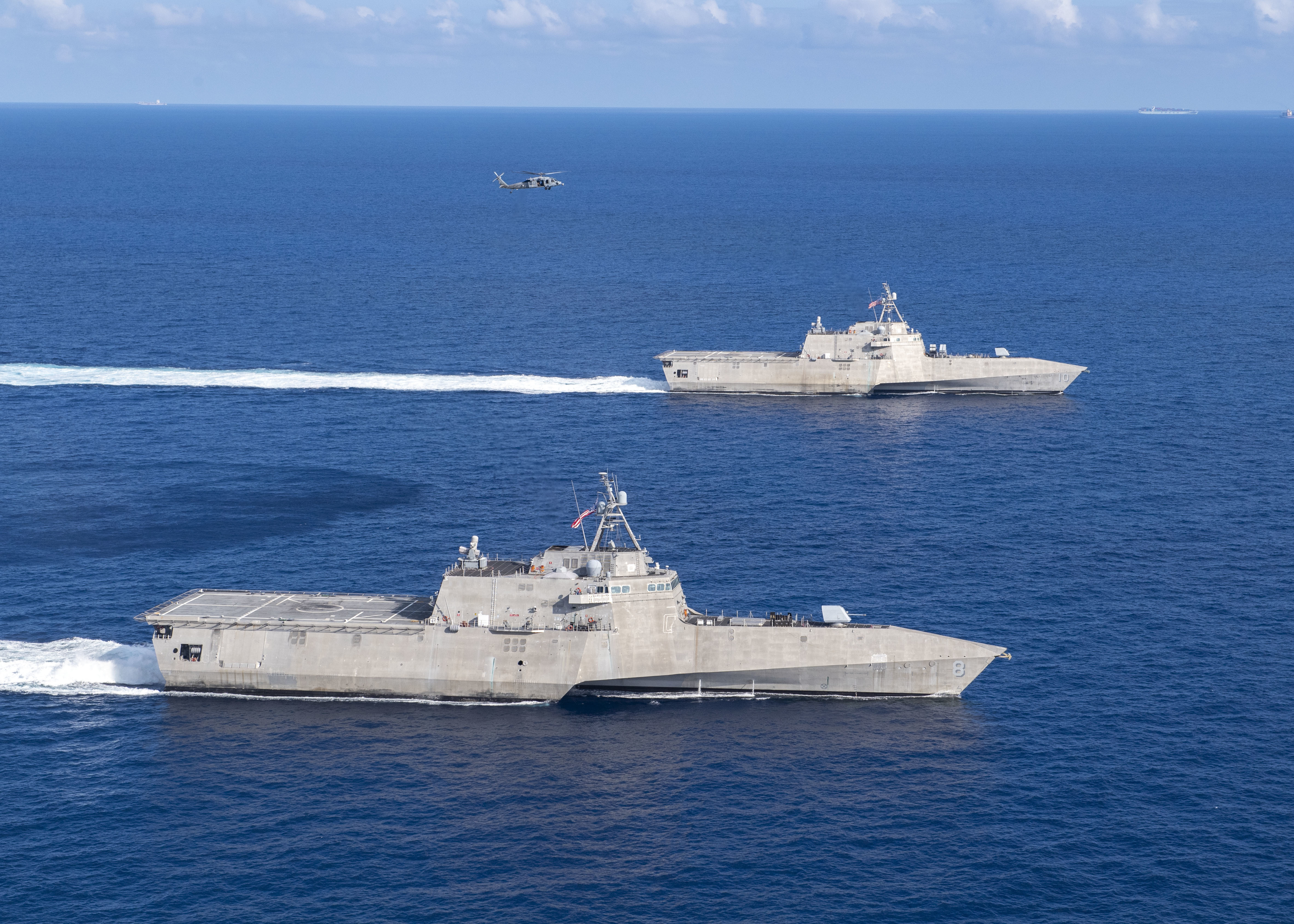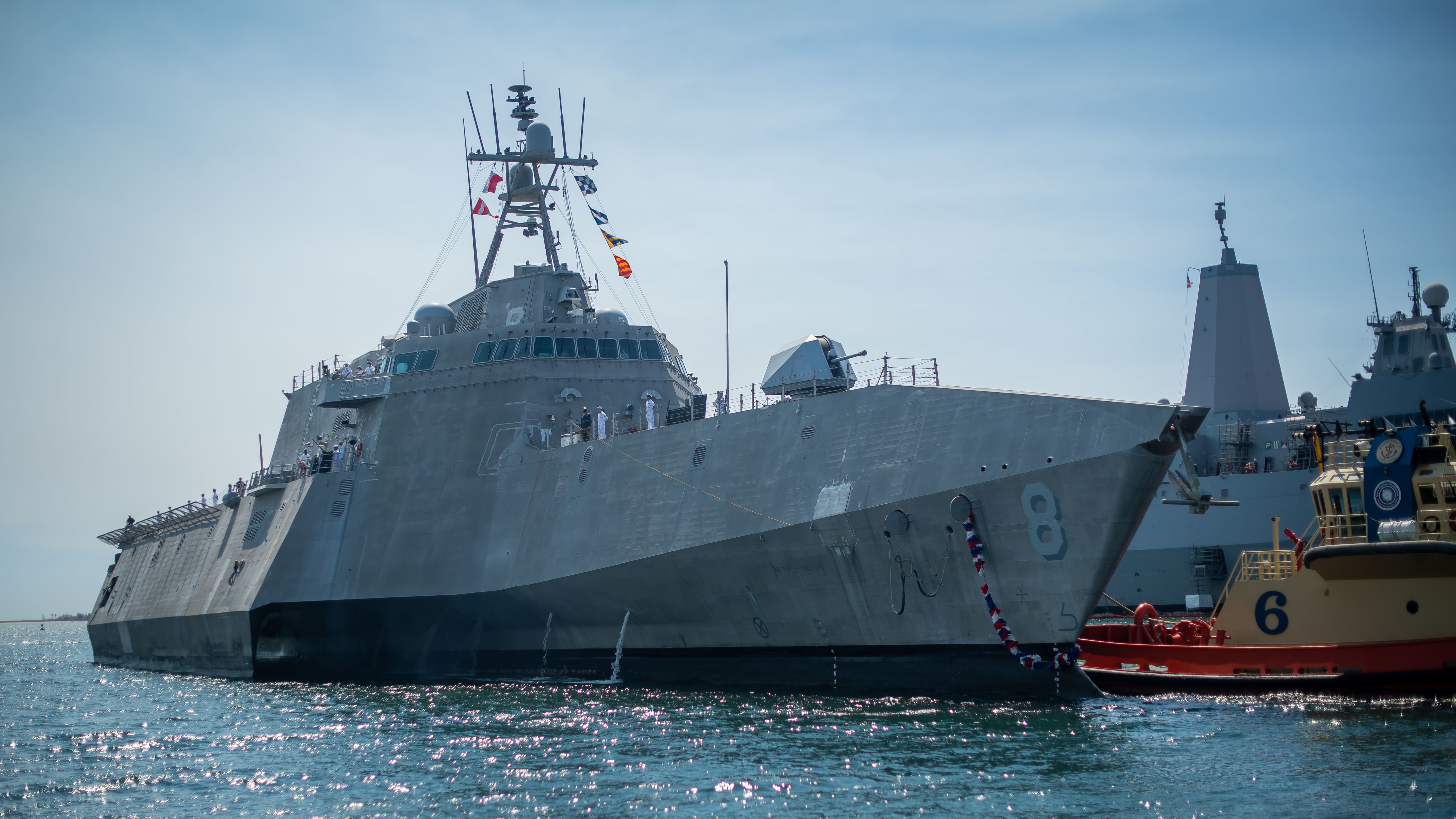
USS Montgomery (LCS-8) recently wrapped up its maiden deployment – and the ship class’s first since a restructure of the Littoral Combat Ship program – and the head of LCS operations said the ship leveraged lessons learned from earlier deployments to avoid readiness problems and make the most of its operational capabilities.
Capt. Jack Fay, who currently serves as the LCS Squadron 1 commodore overseeing all LCSs on the San Diego waterfront, told USNI News that, after the program faced so much early criticism, “it was nice to get over that hump and say, look, LCS is out there doing.”
“The Montgomery deployment in particular was designed to signal to the region: the U.S. is committed to the Indo-Pacific, to free and open waters in accordance with international law. And I think we did that,” said Fay, who served as the Surface Division 11 commodore during most of Montgomery’s deployment and was in Singapore to help oversee some of the manning and maintenance facets. Divisions of four ships each sit under the LCSRON level, with one ship responsible for training the other three ships to their specific warfare area: surface warfare, mine countermeasures or anti-submarine warfare.
Montgomery departed its homeport of San Diego in late May 2019 for a 12-month deployment that would feature multiple swaps between the blue and gold crews, missions in and around small ports that larger combatants can’t access, maintenance out of the LCS hub in Singapore and more.
Fay said the first thing the ship did upon its arrival in Singapore was solidify its relationship with Singapore and other regional partners through training exercises. Then it took on patrol missions in contested waterways like the South China Sea and the Philippine Sea to send a message to both allies and partners and to China that the U.S. Navy was serious about protecting free and open international waters.
By working the high and low end of operations early on, Fay said, Montgomery got the operational commanders in the Pacific “just looking at it as another USS.”

Fay said there were some instances where planning could be better to account for an LCS instead of a destroyer, but there were no missions that Montgomery couldn’t accomplish. In fact, not only could the LCS keep up with the operational tasking from U.S. 7th Fleet and U.S. Pacific Fleet, the LCS proved it had unique capabilities as a small surface combatant that an Arleigh Burke-class destroyer or Ticonderoga-class cruiser couldn’t do.
Having a CRU/DES background himself, Fay said that on previous deployments, “doing exercises in the West Pacific, we’d get a lot of feedback on, you arriving here to do this thing, whatever it was, with a regional partner that was smaller might intimidate them, so be sensitive to that. And I think Montgomery, or LCS writ large, they’re far more kind of equals in terms of numbers of sailors and capabilities, so my suspicion – and this is Jack’s opinion, because I don’t have any direct feedback – is that we delivered to regional partners a level of, okay, we can relate better to this than a destroyer or cruiser.”
Though he was reluctant to name specific ports for security reasons, he said Montgomery was able to make good on the LCS’s promise of getting into shallow or undeveloped ports that larger ships can’t navigate.
“They went to places that I have never seen a cruiser or destroyer go on their first deployment, and I’ll mention countries without mentioning specific locations: in the Philippines, in Indonesia, Thailand, Malaysia and Brunei. So I think we’re delivering on that promise,” Fay said.
USS Gabrielle Giffords (LCS-10) joined Montgomery in theater in September, and Fay said having two LCSs together will provide significant flexibility to operational commanders, with the LCSs taking on solo missions, operating together as an LCS surface action group, and teaming up with carrier strike groups operating nearby.

“We’re at the beginning of doing these recurring deployments, and I expect LCS deployments are just going to continue to increase in numbers,” he said.
“Multiple LCS in theater, especially adding Naval Strike Missile like Gabrielle Giffords has, is a huge huge move forward for the ship class. When I think about what adversaries have to think about – now it’s not just one particular focus area; now they’ve got to look across the entire theater – and that challenges a staff, that challenges their capabilities. I think it was a huge win, and we’re just seeing the start of that, what multiple LCS in theater can do.”
Well before the deployment kicked off last spring, Montgomery was among the first beneficiaries of a newly restructured LCS program that made significant changes on the manning side. An original promise of the LCS was that its minimal manning model would save money for the Navy. Three crews would support two hulls, one of them operating forward at any given time – and this model was meant to keep operational costs down over the life of the ship.
However, it became apparent that the ship needed a larger crew. Too much maintenance work was being postponed for contractors to do in port, rather than the crew being able to keep up day to day. Sailors sometimes had three, four or five roles on a ship, and USNI News was told in a 2016 visit to the waterfront that each ship might have five or six qualified search and rescue divers – far more than larger ships have – because in an emergency those sailors might be called upon to do a more pressing mission.
A 2016 program review and a subsequent overhaul effort changed that, moving each operational LCS to a blue/gold crewing model with a larger number of sailors per crew. Whereas the LCS was originally planned to be manned by just 40 sailors, with a mission package detachment and an air squadron flying on for operations but not contributing to operating and maintaining the ship, the 2016 review recommended a crew of 70 that was trained to operate both the ship and the mission package, as well as a 23-person air detachment.
Still, the 93-strong combined crew is much smaller than on a destroyer, which is manned by about 330 sailors and officers.
Fay said that Commander of Naval Surface Forces Vice Adm. Rich Brown was particularly focused on getting the manning right leading up to the Montgomery deployment, and that manning issues took up a lot of his focus as the division commodore.
“It was really important for me, and really the captains and those executive officers, to make sure they had the right people to do the job because of the numbers of sailors that are on LCS crews. There’s more redundancy built into the cruisers and destroyers by far than there is on LCS, so getting that right was really important and took coordination with a bunch of folks,” Fay said.
“The good news is, we got it right. They went out the door with all the sailors trained and certified as they were supposed to, but it was a lot of work.”
Maintenance was also a big focus for Fay leading up to the deployment. Four LCS deployments had already used a hub in Singapore, but the two deployments by USS Freedom (LCS-1) and the one each by USS Fort Worth (LCS-3) and USS Coronado (LCS-4) were marked by serious maintenance and material readiness challenges.
Fay said the Navy’s Logistics Group Western Pacific and the workforce in Singapore had a great starting knowledge of LCS, with many maintainers and logisticians there having worked with the previous LCSs. They were able to use that knowledge, coupled with the understanding that new maintenance processes and contracts would be in place to address past shortfalls, and Fay said that aspect of the deployment turned out to be a success.
Six to nine months before the deployment, Fay said, he started talking to the workforce in Singapore about the maintenance philosophy for this deployment, how contracts would be executed, what spare parts needed to be kept on hand in case they were needed, and more.
“That was a lesson straight out of the earlier deployments, is that, hey, we need a better parts availability system, we need a better contracting mechanism, and an appreciation for where, when, how and by whom maintenance will be done. We’re far and away better than we were in those initial deployments, and we’ll continue to apply those lessons, because at the end of the day we want our ships to be ready. Things break on ships, it’s not a surprise, and it’s part of that logistics arm to make sure that we have the mechanisms to get them fixed and go back out on task,” he said.

Going forward, though Montgomery didn’t test the expeditionary maintenance model – which Coronado did in 2017 in Vietnam and Gabrielle Giffords will likely do again – Fay said that would become a key feature of LCS operations throughout the entire Pacific.
“I think that’s where we want to go, is being able to do maintenance in more than one location, for a number of reasons. It gives commanders flexibility. It allows the class to operate in different parts of the theater – when you look at the geography of the Indo-Pacific, it is ginormous, and I don’t say that lightly. It’s huge. So if we’re able to demonstrate maintenance capabilities for LCS in other places besides Singapore, the fleet commander gets a huge win. And the more there is capacity to do maintenance, especially when it comes to ship-specific stuff … that’s just an enabler for the force to have that class work as designed where and when needed.”
USNI News asked Fay – now a month into the LCSRON commodore job, leading the entire LCS training and deploying effort on the West Coast – what his biggest takeaway was from the Montgomery deployment and how that would shape his handling of the program going forward.
“What strikes me the most is we are at the start of employing LCS just like any other USS ship that’s on deployment,” he said.
“Forward deployment is what we do, and now we’re contributing like anyone else on the waterfront does. That’s the most exciting part.”





